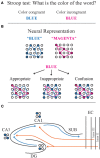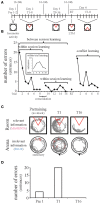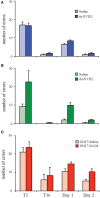Converging on a core cognitive deficit: the impact of various neurodevelopmental insults on cognitive control
- PMID: 24966811
- PMCID: PMC4052340
- DOI: 10.3389/fnins.2014.00153
Converging on a core cognitive deficit: the impact of various neurodevelopmental insults on cognitive control
Abstract
Despite substantial effort and immense need, the treatment options for major neuropsychiatric illnesses like schizophrenia are limited and largely ineffective at improving the most debilitating cognitive symptoms that are central to mental illness. These symptoms include cognitive control deficits, the inability to selectively use information that is currently relevant and ignore what is currently irrelevant. Contemporary attempts to accelerate progress are in part founded on an effort to reconceptualize neuropsychiatric illness as a disorder of neural development. This neuro-developmental framework emphasizes abnormal neural circuits on the one hand, and on the other, it suggests there are therapeutic opportunities to exploit the developmental processes of excitatory neuron pruning, inhibitory neuron proliferation, elaboration of myelination, and other circuit refinements that extend through adolescence and into early adulthood. We have crafted a preclinical research program aimed at cognition failures that may be relevant to mental illness. By working with a variety of neurodevelopmental rodent models, we strive to identify a common pathophysiology that underlies cognitive control failure as well as a common strategy for improving cognition in the face of neural circuit abnormalities. Here we review our work to characterize cognitive control deficits in rats with a neonatal ventral hippocampus lesion and rats that were exposed to Methylazoxymethanol acetate (MAM) in utero. We review our findings as they pertain to early developmental processes, including neurogenesis, as well as the power of cognitive experience to refine neural circuit function within the mature and maturing brain's cognitive circuitry.
Keywords: cognitive control; hippocampus; mental illness; neural coordination; neurodevelopmental insults; schizophrenia models.
Figures






Similar articles
-
Memory deficits with intact cognitive control in the methylazoxymethanol acetate (MAM) exposure model of neurodevelopmental insult.Neurobiol Learn Mem. 2016 Oct;134 Pt B(Pt B):294-303. doi: 10.1016/j.nlm.2016.07.034. Epub 2016 Jul 30. Neurobiol Learn Mem. 2016. PMID: 27485950 Free PMC article.
-
Sub-circuit alterations in dorsal hippocampus structure and function after global neurodevelopmental insult.Brain Struct Funct. 2018 Nov;223(8):3543-3556. doi: 10.1007/s00429-018-1704-3. Epub 2018 Jun 27. Brain Struct Funct. 2018. PMID: 29951917 Free PMC article.
-
A neurobehavioral systems analysis of adult rats exposed to methylazoxymethanol acetate on E17: implications for the neuropathology of schizophrenia.Biol Psychiatry. 2006 Aug 1;60(3):253-64. doi: 10.1016/j.biopsych.2006.01.003. Epub 2006 Apr 11. Biol Psychiatry. 2006. PMID: 16581031 Free PMC article.
-
Stress during critical periods of development and risk for schizophrenia.Schizophr Res. 2019 Nov;213:107-113. doi: 10.1016/j.schres.2019.01.030. Epub 2019 Jan 30. Schizophr Res. 2019. PMID: 30711313 Free PMC article. Review.
-
Cognitive deficits in bipolar disorders: Implications for emotion.Clin Psychol Rev. 2018 Feb;59:126-136. doi: 10.1016/j.cpr.2017.11.006. Epub 2017 Nov 21. Clin Psychol Rev. 2018. PMID: 29195773 Free PMC article. Review.
Cited by
-
Cognitive impairment in epilepsy: the role of network abnormalities.Epileptic Disord. 2015 Jun;17(2):101-16. doi: 10.1684/epd.2015.0739. Epileptic Disord. 2015. PMID: 25905906 Free PMC article. Review.
-
Alterations in sociability and functional brain connectivity caused by early-life seizures are prevented by bumetanide.Neurobiol Dis. 2015 May;77:204-19. doi: 10.1016/j.nbd.2015.02.015. Epub 2015 Mar 10. Neurobiol Dis. 2015. PMID: 25766676 Free PMC article.
-
Memory deficits with intact cognitive control in the methylazoxymethanol acetate (MAM) exposure model of neurodevelopmental insult.Neurobiol Learn Mem. 2016 Oct;134 Pt B(Pt B):294-303. doi: 10.1016/j.nlm.2016.07.034. Epub 2016 Jul 30. Neurobiol Learn Mem. 2016. PMID: 27485950 Free PMC article.
-
Phencyclidine Disrupts Neural Coordination and Cognitive Control by Dysregulating Translation.Biol Psychiatry Glob Open Sci. 2023 May 31;4(1):252-263. doi: 10.1016/j.bpsgos.2023.04.009. eCollection 2024 Jan. Biol Psychiatry Glob Open Sci. 2023. PMID: 38298788 Free PMC article.
-
Impaired cognitive discrimination and discoordination of coupled theta-gamma oscillations in Fmr1 knockout mice.Neurobiol Dis. 2016 Apr;88:125-38. doi: 10.1016/j.nbd.2016.01.003. Epub 2016 Jan 12. Neurobiol Dis. 2016. PMID: 26792400 Free PMC article.
References
-
- Bachevalier J., Beauregard M. (1993). Maturation of medial temporal lobe memory functions in rodents, monkeys, and humans. Hippocampus 3, 191–201 - PubMed
Grants and funding
LinkOut - more resources
Full Text Sources
Other Literature Sources

